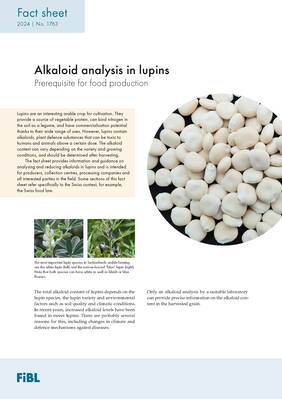Lupins are an interesting arable crop for cultivation. They provide a source of vegetable protein, can bind nitrogen in the soil as a legume, and have commercialisation potential thanks to their wide range of uses. However, lupins contain alkaloids, plant defence substances that can be toxic to humans and animals above a certain dose. The alkaloid content can vary depending on the variety and growing conditions, and should be determined after harvesting.
The total alkaloid content of lupins depends on the lupin species, the lupin variety and environmental factors such as soil quality and climatic conditions. In recent years, increased alkaloid levels have been found in sweet lupins. There are probably several reasons for this, including changes in climate and defence mechanisms against diseases. Only an alkaloid analysis by a suitable laboratory can provide precise information on the alkaloid content in the harvested grain.
The fact sheet provides information and guidance on analysing and reducing alkaloids in lupins and is intended for producers, collection centres, processing companies and all interested parties in the field. Some sections of this fact sheet refer specifically to the Swiss context, for example, the Swiss food law.
Further information
Contact
Link
fibl.org: Fact sheet "Alkaloid analysis in lupins"




